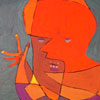artists
Paul Klee (1879-1940)
Paul Klee was born near Berne, Switzerland in
1879. His Swiss mother was an amateur painter and his Bavarian
father was a professor of music. As a child, Klee showed both
musical and artistic talent, but finally decided to become an artist
and went to Munich to study at the Fine Arts Academy. Klee's first
exhibition held in Berne, in 1910, showed the influence of Cezanne,
Matisse, and van Gogh. In 1912, Klee exhibited with the Blaue
Reiter, but by the following year in a series of essays that
appeared in Zurich, he had begun to state his own personal and
spiritual approach to art. Until 1914, Klee had worked only in black
and white or in watercolors, but during that year, on a trip to
Tunisia with Macke, Klee began to see the potential of his use of
color. Influenced by Cubism and interested in both children's and
primitive art, he created small, jewel-like paintings in a personal
language. His basic themes are nature and the man-made world of
buildings and machines, and his works, although simple in
appearance, are complicated in their inner meaning.
Klee's subtly differentiated moods range from laughter to tears. His
witty titles are often as important as the paintings themselves,
which combine an economy and precision of technique with the
markings of a seemingly limitless imagination. Klee taught at the
Bauhaus from 1921 to 1931 and then became professor of Fine Arts in
Düsseldorf. In 1933, nine of his works were included in the
degenerate art exhibition, the Nazis invaded his studio, and he was
suspended from his post. Luckily, Klee was able to take his
paintings, drawings, and writings with him when he sought refuge in
his native Berne, where he continued to work until his death in
1940.
| Figurine: Kleiner Fürtfüfel | ||
|---|---|---|
|
|
|
